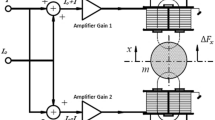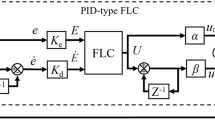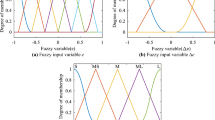Abstract
The performance of the fuzzy controllers depends highly on the proper selection of some design parameters which is usually tuned iteratively via a trial and error process based primarily on engineering intuition. With the recent developments in the area of global optimization, it has been made possible to obtain the optimal values of the design parameters systematically. Nevertheless, it is well known that unless a priori knowledge is available about the optimization search-domain, most of the available time-domain objective functions may result in undesirable solutions. It is consequently important to provide guidelines on how these parameters affect the closed-loop behavior. As a result, some alternative objective functions are presented for the time-domain optimization of the fuzzy controllers, and the design parameters of a PID-type fuzzy controller are tuned by using the proposed time-domain objective functions. Finally, the real-time application of the optimal PID-type fuzzy controller is investigated on the robust stabilization of a laboratory active magnetic bearing system. The experimental results show that the designed PID-type fuzzy controllers provide much superior performances than the linear on-board controllers while retaining lower profiles of control signals.
















Similar content being viewed by others
References
Kumbernuss J, Jian C, Wang J, Yang HX, Fu WN (2012) A novel magnetic levitated bearing system for Vertical Axis Wind Turbines (VAWT). Appl Energy 90:148–153
Van Dijk NJM, Van De Wouw N, Doppenberg EJJ, Oosterling HAJ, Nijmeijer H (2012) Robust active chatter control in the high-speed milling process. IEEE Trans Control Syst Technol 20(4):901–917
Yoo SY, Lee HI, Noh MD (2012) Comparative study of power minimizing control algorithms for active magnetic bearings. In: Proceedings of IEEE/ASME international conference on advanced intelligent mechatronics, pp 155–159
Tezuka T, Kurita N, Ishikawa T (2013) Design and simulation of a five degrees of freedom active control magnetic levitated motor. IEEE Trans Magn 49(5):2257–2262
Shen JX, Tseng KJ, Vilathgamuwa DM, Chan WK (2000) A novel compact PMSM with magnetic bearing for artificial heart application. IEEE Trans Ind Appl 36(4):1061–1068
Lee KC, Jeong YH, Koo DH, Ahn HJ (2006) Development of a radial active magnetic bearing for high speed turbo-machinery motors. In: Proceedings of international joint conference sice-ICASE, pp 6090–6095
Noshadi A, Mailah M, Zolfagharian A (2012) Intelligent active force control of a 3-RRR parallel manipulator incorporating fuzzy resolved acceleration control. Appl Math Model 36(6):2370–2383
Noshadi A, Mailah M, Zolfagharian A (2010) Active force control of 3-RRR planar parallel manipulator. In: Proceedings of 2nd international conference on mechanical and electrical technology, pp 77–81
Noshadi A, Mailah M (2012) Active disturbance rejection control of a parallel manipulator with self learning algorithm for a pulsating trajectory tracking task. Sci Iran 19(1):132–141
Gosiewski Z, Mystkowski A (2008) Robust control of active magnetic suspension: analytical and experimental results. Mech Syst Signal Process 22(6):1297–1303
Balini HMNK, Scherer CW, Witte J (2011) Performance enhancement for AMB systems using unstable \(H_\infty\) controllers. IEEE Trans Control Syst Technol 19(6):1479–1492
Noshadi A, Shi J, Lee WS, Shi P, Kalam A (2014) High performance \(H_\infty\) control of non-minimum phase active magnetic bearing system. In: Proceedings of the 40th annual conference of the IEEE industrial electronics society, pp 183–189
Shi J, Lee WS (2009) An experimental comparison of a model based controller and a fuzzy logic controller for magnetic bearing system stabilization. In: Proceedings of IEEE international conference on control and automation, pp 379–384
Shi J, Lee WS (2010) Design and implementation of conventional and advanced controllers for magnetic bearing system stabilization. In: Polajzer B (ed) Magnetic bearings, theory and applications
Xu JX, Hang CC, Liu C (2000) Parallel structure and tuning of a fuzzy PID controller. Automatica 36(5):673–684
Feng G (2006) A survey on analysis and design of model-based fuzzy control systems. IEEE Trans Fuzzy Syst 14(5):676–697
Sahu BK, Pati S, Mohanty PK, Panda S (2015) Teaching-learning based optimization algorithm based fuzzy- PID controller for automatic generation control of multi-area power system. Appl Soft Comput 27:240–249
Woo ZW, Chung HY, Lin JJ (2000) A PID type fuzzy controller with self-tuning scaling factors. Fuzzy Sets Syst 115(2):321–326
Mann G, Hu BG, Gosine R (1999) Analysis of direct action fuzzy PID controller structures. IEEE Trans Syst Man Cybern Part B Cybern 29(3):371–388
Mann G, Hu BG, Gosine R (2001) Two-level tuning of fuzzy PID controllers. IEEE Trans Syst Man Cybern Part B Cybern 31(2):263–269
Noshadi A, Shi J, Lee WS, Kalam A (2014) PID-type fuzzy logic controller for active magnetic bearing system. In: Proceedings of 40th annual conference of IEEE industrial electronics, pp 241–247
Noshadi A, Shi J, Poolton S, Lee WS, Kalam A (2014) Comprehensive experimental study on the stabilization of active magnetic bearing system. In: Proceedings of Australasian universities power engineering conference, pp 1–7
Wu Z, Shi P, Su H, Lu R (2014) Dissipativity-based sampled-data fuzzy control design and its application to truck-trailer system. IEEE Trans Fuzzy Syst. doi:10.1109/TFUZZ.2014.2374192
Wu Z, Shi P, Su H, Chu J (2014) Sampled-data fuzzy control of chaotic systems based on a T-S fuzzy model. IEEE Trans Fuzzy Syst 22(1):153–163
Liu J, Yang OW (2013) A stable fuzzy logic controller using the least parameter for explicit traffic control. Int J Innov Comput Inf Control 9(7):2801–2819
Harinath E, Mann G (2008) Design and tuning of standard additive model based fuzzy PID controllers for multivariable process systems. IEEE Trans Syst Man Cybern Part B Cybern 38(3):667–674
Vick A, Cohen K (2009) Longitudinal stability augmentation using a fuzzy logic based PID controller. In: Proceedings of annual meeting of the North American fuzzy information processing society, pp 1–6
Wolpert DH, Macready WG (1997) No free lunch theorems for optimization. IEEE Trans Evol Comput 1(1):67–82
Noshadi A, Shi J, Lee WS, Shi P, and Kalam A (2014) Genetic algorithm-based system identification of active magnetic bearing system: a frequency-domain approach. In: Proceedings of 11th IEEE international conference on control & automation, pp 1281–1286
Shi J, Kalam A, Noshadi A, Shi P (2014) Genetic algorithm optimised fuzzy control of DSTATCOM for improving power quality. In: Proceedings of Australasian universities power engineering conference, pp 1–6
Zolfagharian A, Noshadi A, Khosravani MR, Mohd Zarhamdy MZ (2014) Unwanted noise and vibration control using finite element analysis and artificial intelligence. Appl Math Model 38(9):2435–2453
Yang J, Gao H, Liu W (2015) Hybrid method of chaotic genetic algorithm and boundary simulation for constrained optimization. Int J Innov Comput Inf Control 11(3):1059–1073
Kennedy J, Eberhart R (1995) Particle swarm optimization. In: Proceedings of IEEE international conference on neural networks, pp 1942–1948
Shi Y, Eberhart R (1998) A modified particle swarm optimizer. In: Proceedings of evolutionary computation, pp 69–73
Mirjalili S, Mirjalili SM, Lewis A (2014) Grey wolf optimizer. Adv Eng Softw 69:46–61
Saremi S, Mirjalili S, Mirjalili S (2014) Evolutionary population dynamics and grey wolf optimizer. Neural Comput Appl 26(5):1257–1263
Atashpaz-Gargari E, Lucas C (2007) Imperialist competitive algorithm: an algorithm for optimization inspired by imperialistic competition. In: Proceedings of IEEE congress of evolutionary computation, pp 4661–4667
Rajabioun R, Atashpaz-Gargari E, Lucas C (2008) Colonial competitive algorithm as a tool for nash equilibrium point achievement. In: Computational science and its applications—iccsa. Springer, Berlin Heidelberg, pp 680–695
Xue D, Chen Y, Atherton DP (2007) Linear feedback control: analysis and design with MATLAB. Siam
Author information
Authors and Affiliations
Corresponding author
Rights and permissions
About this article
Cite this article
Noshadi, A., Shi, J., Lee, W.S. et al. Optimal PID-type fuzzy logic controller for a multi-input multi-output active magnetic bearing system. Neural Comput & Applic 27, 2031–2046 (2016). https://doi.org/10.1007/s00521-015-1996-7
Received:
Accepted:
Published:
Issue Date:
DOI: https://doi.org/10.1007/s00521-015-1996-7




